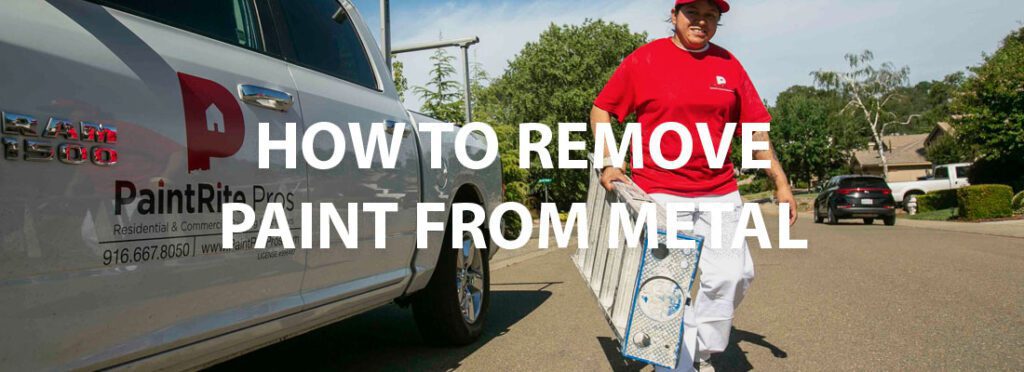
When it comes to certain DIY projects, people often wonder just how to remove paint from metal. Removing paint from metal isn’t difficult but can be rather tedious and come with potential dangers. Luckily, there are several different ways to remove paint from metal. In this article, we’ll go over the most common ways along with the tools and supplies you’ll need to complete your project successfully. With a little knowledge and prep work, your faded metal furniture or railing can look good as new.
If you live in the Sacramento area and need help with paint removal and painting, click the button below to get a free estimate. We serve the entire area including Dixon and Stockton.
Do You Paint Walls or Trim First?
Paint Removal on Metal
Painting metal is easy, it’s the removal of paint from metal that can be tricky. Paint typically bonds to metal really well which makes removal a bit of a complicated process. Fortunately, there are several home remedies involving common household products such as vinegar and baking soda that are worth looking into.
Different Ways to Remove Paint from Metal
There are a variety of ways to remove paint from metal. Some methods are certainly more intense than others. Consider the tools and supplies you already have on hand as well as which technique may be most appropriate for your specific project.
-
Removing Paint with a Metal Scraper
Metal scrapers used to be really the only option when it came to removing paint from metal. Even though it certainly worked, it was extremely time-consuming and exhausting. However, after years of technological advances, a more modern and effective scraper has been introduced. An updated version of a metal paint scraper is filled with chemical depositions. Tiny pores in the tip of the tool allow the chemicals inside the scraper to flow onto the metal surface. This allows the chemicals to take effect combined with the benefits of mechanical scraping.
-
Using a Heat Gun to Remove Paint
Heat guns work by causing the paint to melt away from your metal surface. Simply hold the gun a few inches away from the metal surface, taking care to slowly move it back and forth. It’s very important to note that high temperatures of heat can potentially warp metal surfaces. Start with applying the lowest heat setting available and work your way hotter as needed. You should be able to easily remove the bubbling paint with a paint scraper or old cloth. Wear gloves and protective eyewear from start to finish.
-
Acidic Concentrations
Acidic concentrations are an extremely effective solution to remove paint from metal with minimal effort and quick results. The moment the acidic solution reacts with the metal surface, the paint peels off and the solution evaporates.
Take note that this process, while very effective, should be done with the utmost care. The acids involved are nitric, hydrochloric, and phosphoric acid. This means that acidic concentration should only be used when removing paint that is hard or difficult to remove such as acrylic or latex. The paints that tend to come off easier like oil and enamel aren’t the best candidates for acid concentrations.
-
Chemical Solutions-Stripping Paint Off Metal
There are several different varieties of paint strippers on the market, created to make a chemical reaction to easily remove paint from metal. Simply pour the paint stripper or chemical solution into a container and use a chip brush to apply a generous layer to the object. Allow approximately 30 minutes to several hours for the chemicals to react and for the paint to start bubbling and peeling away. Use a rag to wipe away the liquid as well as the sloughed-off paint. Due to the chemical nature of these products, work only in well-ventilated rooms or outdoors.
-
Baking Soda
Baking soda is inexpensive and probably something most people already have in their cupboards or fridge. It’s also used as a cleaning agent in bathrooms, doing laundry, and even when cleaning carpets. However, you might not have known that baking soda can also effectively remove paint from metal.
You can place smaller metal items in a solution of baking soda and water (16:1 ratio) that is boiling for 15 minutes and then remove it. Any remaining paint should be easy to remove. You can also replace vinegar with baking soda in this scenario and still have successful results. When working with a project of a larger nature, another approach may be more appropriate.
Useful Tools and Supplies for Removing Paint from Metal
Different supplies will obviously be more helpful when using some paint removal methods over others. However, we’ve compiled a general list of things that will come in handy and ensure your best success possible when removing paint from metal.
- Heat-resistant gloves and safety goggles
- Dust mask
- Putty knife or paint scraper
- Chip brushes
- Paint stripper
- Clean rags
- Disposable container
- Drop cloths or plastic sheets
Helpful Paint Removal Tips
- Closely follow all directions when working with chemical or paint stripping solutions.
- Avoid the use of wire brushes or sandpaper on metal as you may damage its surface.
- Wear long sleeves and long pants.
- Work in a well-ventilated area with no flammable objects in close proximity.
- When finished, dispose of all chemicals, paint, or rags used in the process responsibly.
How to Remove Paint From Metal Conclusion
While removing paint from metal can certainly be done, it can be very time-consuming and a tedious process. If you don’t feel up to the task or feel your project would best be handled by professionals, contact PaintRite Pros. Our experienced team of skilled painters can help with any interior or exterior painting project in the Sacramento area. Contact us for a free estimate today.


